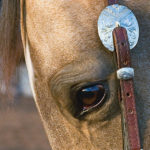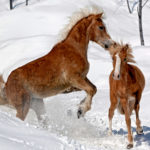Bucking is a dangerous habit that should be halted as quickly as possible. Many horses never try to buck when ridden, and so never learn they can. Others, more “ticklish,” may buck once or twice when first saddled and ridden (especially if their trainer has skipped their early groundwork so they’re ill-prepared for transitioning to a rider).

Some horses that do buck in training give it up after they find it doesn’t gain anything, and they’ve become accustomed to the saddle. If, however, the green horse ever dumps his rider during this early training phase, he may learn that bucking puts him in control, over the rider—and so he continues using it as an evasive tactic.
Some horses buck instantly and without thinking whenever they’re startled or annoyed; bucking may also be a horse’s reaction to pain or irritation from ill-fitting tack. Mixed signals or confusing cues from you, the rider, can also sometimes bring it on.
I’m going to talk about three common scenarios where bucking occurs. I’ll explain why your horse may buck in these situations, then give you strategies for changing his bucking habit.

Bucks in Lead Changes
What causes it? The easiest gait from which a horse can start bucking is the lope. Thus, if your horse is confused or frustrated with how you ask for a change of lead, he may use it as an opportunity (or excuse) to buck.
To change this habit:
• First, make sure there isn’t a physical reason your horse doesn’t want to change leads. If he’s subtly favoring a leg or foot, for instance, he might resist changing to the lead that puts more weight and stress on the sore limb.
• Examine your methods and cues for asking for a change of lead. If your horse doesn’t understand what you’re asking or finds it difficult to respond because of how you have (or haven’t) set him up, he may buck out of frustration. Get an expert’s advice and refine or modify your cues as necessary to find what will work best for your particular horse.
What if nothing works? Retrain the lead change from the start, going back to asking for a simple change of lead through the trot until your horse understands and is responding consistently. If he still bucks when you progress again to asking for a flying change, get hands-on help from a professional who can assess the problem and determine what subtle communication error or other glitch may be causing your horse’s bucking.
Bucks to Get Rid of the Rider
What causes it? Your horse has learned he has the ability to buck a rider off, so he tries this tactic whenever he doesn’t want to do what you’ve asked. This is an especially dangerous habit, as it can easily catch you by surprise. You must remain alert, and continually and consistently head off his attempts to buck for him to give up trying.
To change this habit:
• First, make sure there’s nothing annoying your horse, such as an ill-fitting saddle, cinch, or bit/bridle. Also make sure your riding techniques aren’t irritating him or causing him discomfort (check with an expert if you’re not sure). You want to be certain you’re not giving him an excuse to buck; otherwise you’re just working against yourself as you’re trying to change his habit.
• Ride your horse daily and get him into the routine of steady work. Some horses are most prone to buck after they’ve had time off; they buck due to high spirits or just plain unwillingness to go back to work again. Groundwork before you mount up, always a good idea, is especially important here. Many horses settle down and become more honest with vigorous daily work.
• Whenever you’re first putting your horse back to work, avoid situations in which he might be most likely to buck. For example, a horse in high spirits with energy to burn may try to buck when asked to lope, so keep your first ride down to brisk walking and trotting. Also keep in mind the presence of other horses can increase reactiveness, and that it’s a lot easier to buck heading downhill than up.
• Improve your riding skills so you’re always in control and able to halt a bucking attempt—or at least keep your horse from bucking hard enough to throw you. Maintain light contact and communication with his mouth; this can help you thwart a hard buck, as it enables you to keep your horse from suddenly dropping his head. (He must be able to lower his head at least to the level of his knees to buck hard. If his neck is kept at or above the horizontal, though he might be able to leap forward or sideways and kick out with his hind feet, he won’t be able to get enough hump in his back to buck explosively.)
• As an alternative way to keep his head up, leave your horse’s halter on under his bridle. Attach a lead to the halter and secure it to your saddle horn so your horse has just enough slack for normal head and neck movement, but not enough to put his head down to knee level.
• If your horse is a strong bucker and you’re unsure of your ability to keep his head up in a snaffle bridle, changing to a mild curb might give you the extra help you need. Make the transition to a stronger bit as a last resort, and do it only if your hands are skilled enough to handle it properly (seek advice from a professional trainer or instructor).
• If your horse tries to buck in spite of all your efforts, halt the bucking action by immediately drawing his head around to the side. He can’t buck while spinning in a circle. If you need extra leverage for drawing his head to the side, ride with his halter on under the bridle and an extra set of reins snapped to the side rings on the halter. This way, you can put pressure on his head and nose, as well as on the bit, to draw him around in a circle.
• Talk to your horse calmly when he comes to a stop following a buck. As soon as you get him completely quiet, praise him for standing still. Never punish him for bucking after he’s stopped, regardless of the cause, or he’ll think you’re punishing him for standing still. When he bucks in an attempt to dislodge you, the time for punishment is when he starts the activity, not when he stops. A jab with your heel as you pull his head up and spin him around may be enough to make him realize bucking is not pleasant. After he’s back under control, stay calm and relaxed as you continue with your ride to show him everything is pleasant when he behaves.
What if nothing works? Some horses never become totally dependable, despite all measures. If yours is one of these, you must ride him with constant vigilance and attention so you’re never caught off guard. If your horse bucks so explosively that he’s able to unseat you, he needs to be ridden by someone who can control him; you’re better off finding a horse you can manage safely.
Bucks When Startled or Annoyed
What causes it? A green or inexperienced horse may “buck first and ask questions later” when startled—as by a deer jumping out of the brush, a branch tickling his belly when he goes through a thicket, or the bite of a horse fly. An inadvertent bump in the mouth or jab with a spur might also do it, as can the pinch of an ill-fitting saddle or cinch. If your horse is green, the ideal is to catch and defuse this behavior promptly so it doesn’t become a confirmed habit.
To change this habit:
• Seek out the cause and take action: Check the horse’s tack and your technique, making adjustments as needed. If he’s ticklish and jumpy when riding through brush or thistles, for example, take time to get him used to being touched on his sides and belly. Whatever the cause of your horse’s defensive action, address it in a way that either eliminates it (as with ill-fitting tack) or accustoms him to it (as with a surprise touch on his belly, the approach of strange horses, sudden loud noises, etc.).
• Whether your horse is green or not, stay alert and ride with conscientious forethought and attentiveness to up your odds of remaining in control. Don’t “go to sleep” on him or sit like a mere passenger. Keep up an ongoing flow of communication through the reins to the bit to keep him paying attention to you.
What if nothing works? As with a horse that bucks to dump his rider, you may have to make a decision. If your horse continues to buck whenever startled and you don’t feel capable of eliminating this defensive action, or you’re unsure of your ability to stay on, get help from an experienced rider or trainer. Or let the horse go to someone who can handle him and get yourself a more reliable mount.
Heather Smith Thomas is a prolific freelance writer and the author of 20 books on horse training and management. She and her husband raise beef cattle and horses on a ranch in the mountains of eastern Idaho; she’s pictured with her mare Ed.






